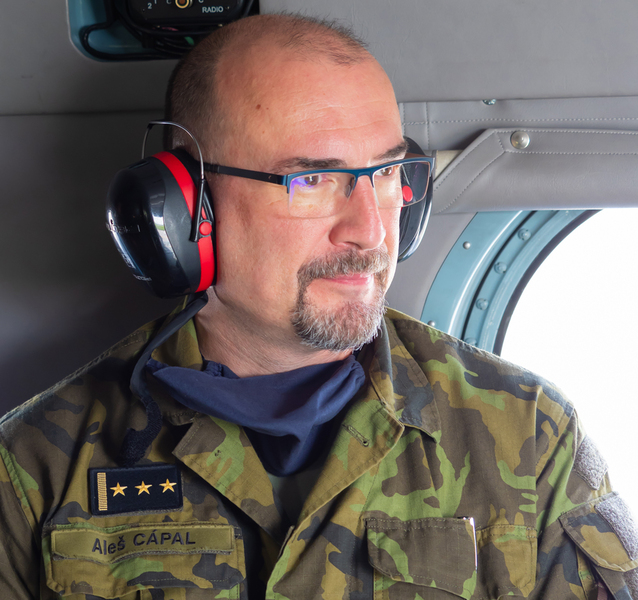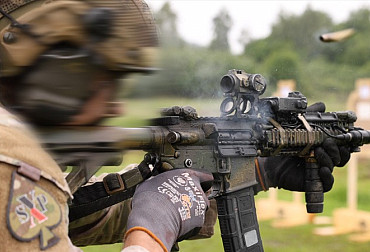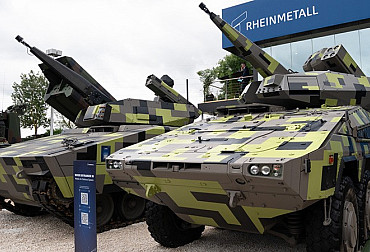Aleš Cápal: This year's AMPLE STRIKE exercise was successful and better than I expected
The 8th edition of the Ample Strike international exercise has recently ended. It was aimed at coordinating the activities of Forward Air Controllers with aircrews, helicopters and ground commanders in a multinational environment, practicing direct air support tasks, testing the host country's ability to provide support to foreign troops and the ability to refuel in flight.
 Picture: The main objective of this year's exercise was to align the activities of Forward Air Controllers with aircrews and ground commanders in an international environment. | Ministry of Defence of the Czech Republic
Picture: The main objective of this year's exercise was to align the activities of Forward Air Controllers with aircrews and ground commanders in an international environment. | Ministry of Defence of the Czech Republic
The main objective of this year's exercise was to coordinate the activities of Forward Air Controllers with aircrews and ground commanders in an international environment. "14 JTAC (Joint Terminal Attack Controller) teams from 9 NATO member states conducted a total of 889 aircraft target guidance missions during the exercise. The crews of more than 20 aircraft and helicopters spent a total of 450 hours in the Czech Republic's airspace," said AIROPS Group Chief, Capt. J.H.
More than 150 members of the allied armies, a total of 600 soldiers, took part in the largest air exercise. The exercise took place at the airfields of Náměšt' nad Oslavou, Čáslav, Pardubice, Boletice training area and Bechyně garrison. "We were very pleased that we could participate. The dynamic scenarios were well prepared, we used a variety of means that we do not normally work with for guidance," said a Dutch instructor. He also spoke highly of the level of training of the Czech pilots of Mi-24 Hind helicopters and JAS-39 Gripen aircraft.
 Picture: JAS-39 Gripen | Ministry of Defence of the Czech Republic
Picture: JAS-39 Gripen | Ministry of Defence of the Czech Republic
These two aircraft represented the Air Force of the Czech Army, supplemented by Mi-171 Hip and L-159 Alca. The Hungarian JAS-39 Gripen, the Dutch L-39C Albatros, the German Learjet LJ-35 and Pilatus PC-9 trainer aircraft were also heavily involved in the exercise. The Texas National Guard contributed a unique MQ-9 Reaper drone, which operated from the Czech Republic for the first time.
 Picture: F-15 Strike Eagle refuelling in flight | Ministry of Defence of the Czech Republic
Picture: F-15 Strike Eagle refuelling in flight | Ministry of Defence of the Czech Republic
American F-15 Strike Eagle fighter pilots also made their debut at AMPLE STRIKE. In addition to Close Air Support (CAS) operations, they conducted in-flight refueling operations in cooperation with American KC-135 Stratotankers. The F-15s took off from the British RAF base at Lakenheath and refueled in the area over České Budějovice.
We asked the exercise director, Colonel Aleš Cápal, a few questions about AMPLE STRIKE 2021:
How would you evaluate this year's AMPLE STRIKE exercise in the context of its purpose and objectives?
I am extremely satisfied with the preparation and conduct of the exercise. In spite of the adverse epidemiological situation during the planning and preparation period of the exercise, we managed to convince partners to participate and to obtain enough aviation equipment to create good conditions for the training of fifty air navigators from nine countries.
The feedback and evaluation of the participants also indicates that satisfaction was on all sides. The main objectives of the training - the acquisition, renewal and maintenance of air controller qualifications - were achieved.

Picture: Colonel Aleš Cápal | Jan Hlaváč / Ministry of Defence of the Czech Republic
Did everything work out as originally intended? E.g. aerial refuelling, JTAC interoperability, etc.?
Successful and better than expected. The activities of the Czech Air Force from the bases in Čáslav and Náměšt', the contributions of alliance partners from airfields abroad, the possibility of aerial refuelling, the use of remotely piloted Reaper aircraft or contracts with civilian aircraft providers have enabled us to fly from morning to night in three operational areas. This was a prerequisite for the success of this year's exercise.
I rate the background support of the visiting forces at Náměšt' nad Oslavou Airport, Pardubice Airport, Bechyně Garrison and Boletice Military Area as excellent and I thank everyone for their impeccable work.
We flew 450 hours and performed almost 900 sorties. As every year we have a lot of knowledge from the allied troops and from our own troops, which we will now evaluate in order to be a bit better in the coming years.
What did you personally like most about this year's exercise?
Personally, I was impressed by the team spirit of the exercise. As the start date of the exercise approached, I had the opportunity to observe the work of the exercise planning and management team, their communication with partners from the Czech Armed Forces and NATO. Their absolute focus and proactive approach to problem solving was exemplary, I am really proud of them, they deserve the highest praise.
 Picture: JTACs with soldiers from Bechyně | Ministry of Defence of the Czech Republic
Picture: JTACs with soldiers from Bechyně | Ministry of Defence of the Czech Republic
Huge thanks go to the crews of all aircraft types for their excellent attitude and open communication in performing the tasks set, without their professionalism and enthusiasm for flying we could never have carried out the exercise.
Moreover, this year the weather was absolutely perfect, eight out of ten flying days were clear and cloudless, even the two remaining days were flying and guiding.
The US MQ-9 Reaper unmanned aerial vehicle (UAV) was not at this year's exercise for the first time, but it was the first time this year that it took off from the domestic 22nd Helicopter Air Base (in the past it has taken off from Poland). What was involved in allowing the drone to take off from the Czech base?
It was preceded by many months of preparation and cooperation with military and civilian forces responsible for safe operation in the Czech airspace. The basis for success was the work of specialists from our base and the 26th Command, Control and Reconnaissance Regiment. Their proposals were then assessed and further refined by the Air Force Headquarters and the Military Aviation Supervision Department. Only when all conceivable risks were accurately described and reduced to an acceptable level was the documentation submitted to the Civil Aviation Authority for approval.
 Picture: MQ-9 Reaper | Ministry of Defence of the Czech Republic
Picture: MQ-9 Reaper | Ministry of Defence of the Czech Republic
The safety of airspace operations is an absolute priority for the organisation of such a large-scale exercise.
What is the outlook for next year? Are you planning any changes or innovations?
Next year, the Air Force and the entire Czech Army will focus on the operational preparation of units in the context of changes in the command and control structure. We plan to conduct several small exercises at the base focused on JTAC training based on bilateral relations. We definitely want to continue cooperation with our Alliance partners, but for now everything is in the planning phase. We will soon find out what the exact name of next year's exercise will be, but it is clear that it will fit into the concept of the RESISTANT CZECHLAND national exercise.
We would like to organize AMPLE STRIKE again in 2023 and we hope for the support of NATO and MTEP. It is a unique exercise whose impact on the quality and interoperability of air navigator training goes well beyond the borders of the Czech Republic.





















